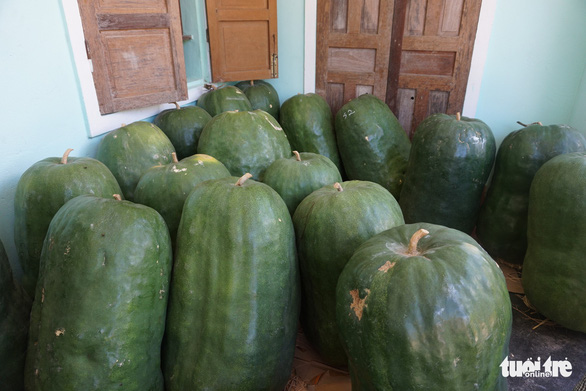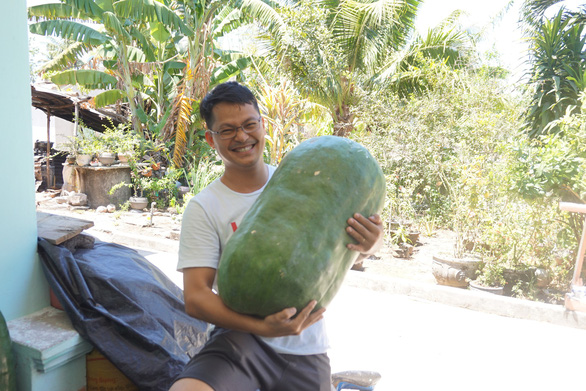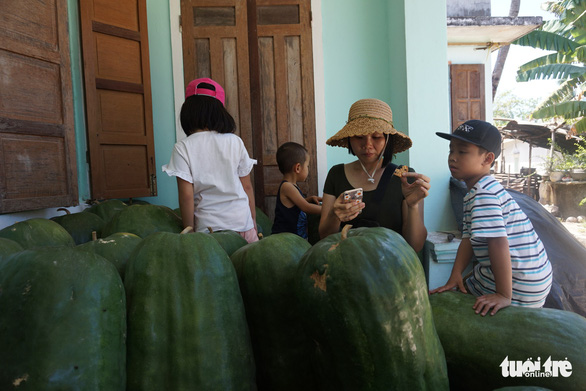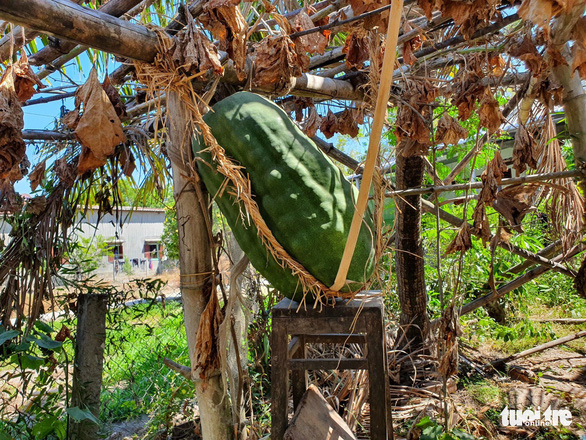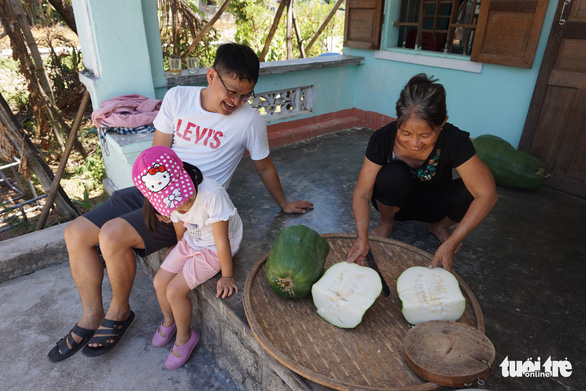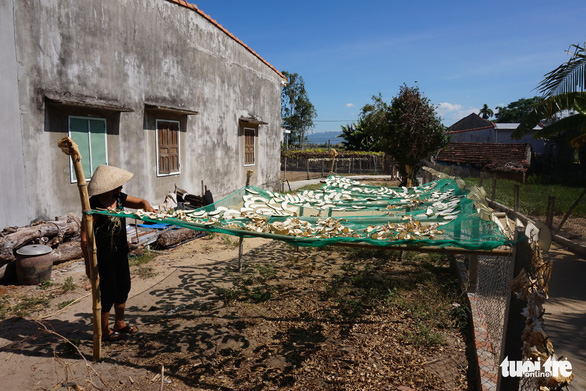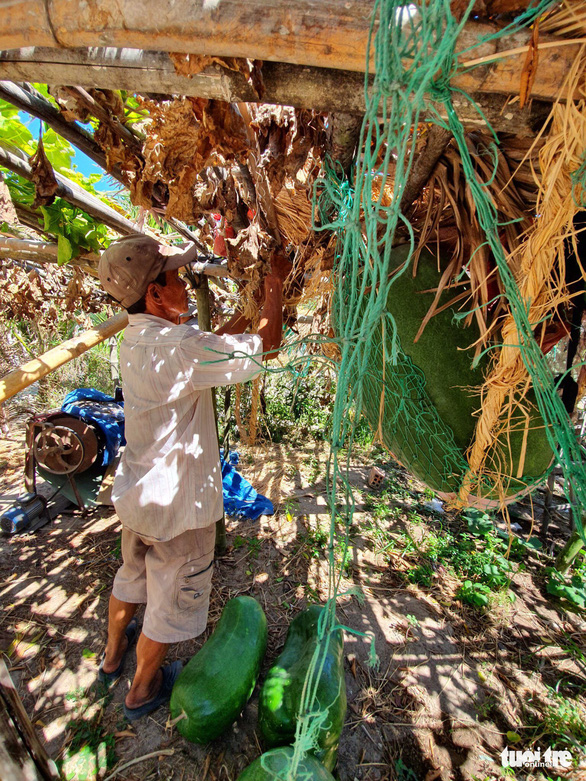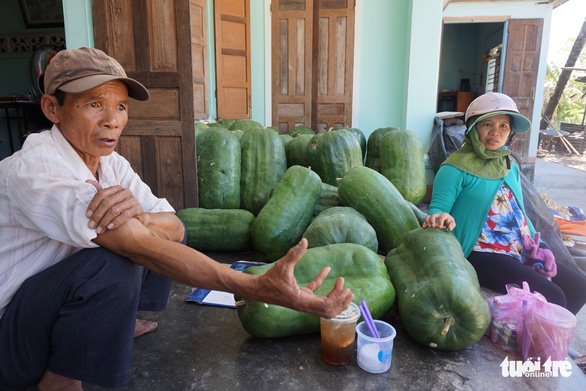A village in Vietnam is known for producing mammoth winter melons despite their low commercial value.
“As big as a wax gourd” is a popular saying in Chanh Trach Village, My Tho Commune, Phu My District, located in the south-central province of Binh Dinh, where this unique species of gigantic winter melon originates.
Unlike the normal-sized wax gourds typically found in most Vietnamese markets, gigantic winter melons grown in Chanh Trach have a cylindrical and dark green shell, white flesh, and average weights between 40kg and 50kg.
In optimal conditions, the melons can grow a whopping one kilogram per day until peaking at 80kg.
Surprisingly, Chanh Trach farmers avoid plant growth stimulants and stick to natural soy bean pulp and fertilizers to keep their winter melon crop healthy.
As the gourds become larger, rice straws, nets, and even wooden chairs are used to support them.
|
|
| A man holds a giant winter melon in Chanh Trach Village, My Tho Commune, Phu My District, Binh Dinh Province. Photo: Ngoc Diep / Tuoi Tre |
|
|
| A crop of giant winter melons is seen in Chanh Trach Village, My Tho Commune, Phu My District, Binh Dinh Province. Photo: Ngoc Diep / Tuoi Tre |
In addition to using the melon’s flesh for cooking, sap from the plant’s stem can be preserved for a couple of years and is often drunk as a hangover cure.
“One stem can contain three liters of sap,” Nguyen Bay, a 62-year-old winter melon farmer from Chanh Trach, told Tuoi Tre (Youth) newspaper.
According to Bay, it takes about six months until the melons are ready for harvest.
But even with such a massive investment of time, the pay-off is relatively small.
“Their economic value is not as high as more common vegetables and produce, so many households are gradually giving up planting wax gourds,” he said.
Bay’s family is one of the few households left in the region who still grow the mammoth melons.
|
|
| A giant winter melon supported by a wooden chair in Chanh Trach Village, My Tho Commune, Phu My District, Binh Dinh Province. Photo: Ngoc Diep / Tuoi Tre |
|
|
| A farmer slices a giant winter melon in Chanh Trach Village, My Tho Commune, Phu My District, Binh Dinh Province. Photo: Ngoc Diep / Tuoi Tre |
According to Le Thi Vinh Huong, deputy director of the Binh Dinh tourism department, there are no official scientific data on the origin of the special wax gourd, which grows healthily and exclusively in Chanh Trach Village.
“But many believe the locality’s unique soil and climate are behind the incredible size of the melons,” she added.
Last November, the National Office of Intellectual Property of Vietnam officially recognized Chanh Trach-grown winter melons as a collective brand.
However, the classification has done little to improve the popularity of the melons considering their limited availability and the difficulty in transporting them.
The Agricultural Science Institute for Southern Coastal Central Vietnam (ASISOV) once tried growing Chanh Trach winter melons in Phuoc An Commune, Tuy Phuoc District, 66km away from Chanh Trach Village, but it was only able to cultivate melons up to 18kg.
“I only found out about these special wax gourds in 2013 even though I live just 14km away in Binh Duong Town,” said Nguyen Ngoc Thach, director of Binh Long Travel Company that now hosts tours for visitors to explore the wax-gourd village.
|
|
| A farmer place slices of giant winter melon on a net for drying in Chanh Trach Village, My Tho Commune, Phu My District, Binh Dinh Province. Photo: Ngoc Diep / Tuoi Tre |
|
|
| Slices of giant winter melon are dried on a fence in Chanh Trach Village, My Tho Commune, Phu My District, Binh Dinh Province. Photo: Ngoc Diep / Tuoi Tre |
|
|
| A farmer ties a net to support a giant winter melon in Chanh Trach Village, My Tho Commune, Phu My District, Binh Dinh Province. Photo: Ngoc Diep / Tuoi Tre |
|
|
| Two farmers with their crop of giant winter melons in Chanh Trach Village, My Tho Commune, Phu My District, Binh Dinh Province. Photo: Ngoc Diep / Tuoi Tre |
Like us on Facebook or follow us on Twitter to get the latest news about Vietnam!



